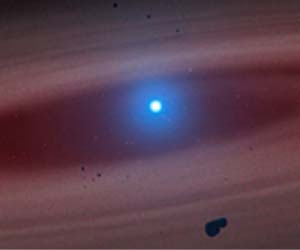Vega Star Facts

Vega is surrounded by a disc of debris, possibly as the result of planetary collisions.
- Vega (pronounced vee-ga) is 25 light years from Earth.
- Vega is surrounded by a large disc of dust, which suggests that planet forming activity is or has taken place.
- Due to its higher mass Vega burns its fuel at a much quicker rate than our sun.
- The main sequence lifespan of Vega is expected to be around 1 billion years, compared to the 10 billion years of our sun.
- Vega will become a red giant in around half a billion years when it can no longer fuse hydrogen in its core.
- Vega rotates extremely quickly, once every 12 and a half hours compared to the 28 days it takes the sun to rotate on its axis.
- Vega's rapid rotation causes the star to bulge considerably at its equator.
- As a result of its brightness and close proximity Vega is the most studied star apart from the sun.
- In 10,000 years Vega will replace Polaris as the northern pole star.
- In 1850 Vega became the first star ever to be photographed.

A NASA Spitzer Space Telescope image of Vega, the fifth brightest star in the night sky.
Vega Radius
Vega is a bluish-white star with a radius of around 1.1 million miles (1.8 million km), which is around two and a half times the size of the sun.
Vega Mass
Vega is estimated to have a mass of around 2.1 times that of the sun.
Vega Temperature
Vega is estimated to have surface temperatures of around 9,500C (17,000F), which is almost as twice as hot as the sun.
Vega Luminosity (energy emitted)
Due to its larger size and higher surface temperatures Vega has a luminosity around 40 times greater than that of our sun.
Vega Statistics
Also Known As: Alpha LyraeDistance From Earth: 25 light years
Constellation: Lyra
Star Type: White main sequence star - A Class
Mass: 2.1 x Sun
Luminosity: Approx 40 x Sun
Diameter: Approx 2.2 million miles (3.5 million km) - 2.5 x the Sun
Temperature: Approx 9,500C (17,000F)
Age: Approx 500 million years old
Rotation Period: 12.5 hours